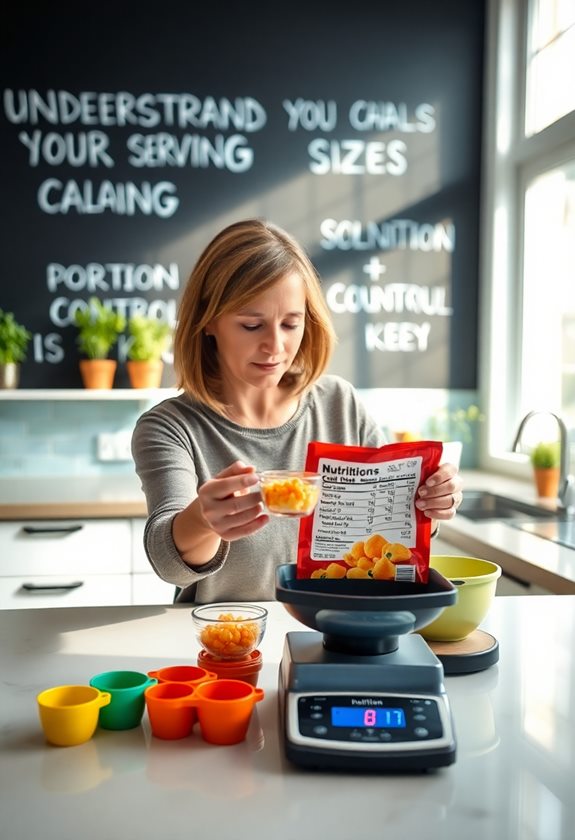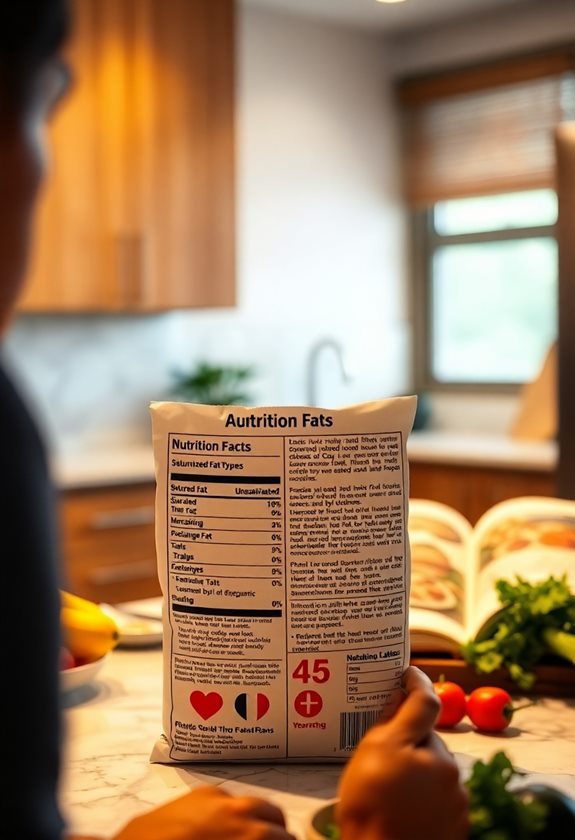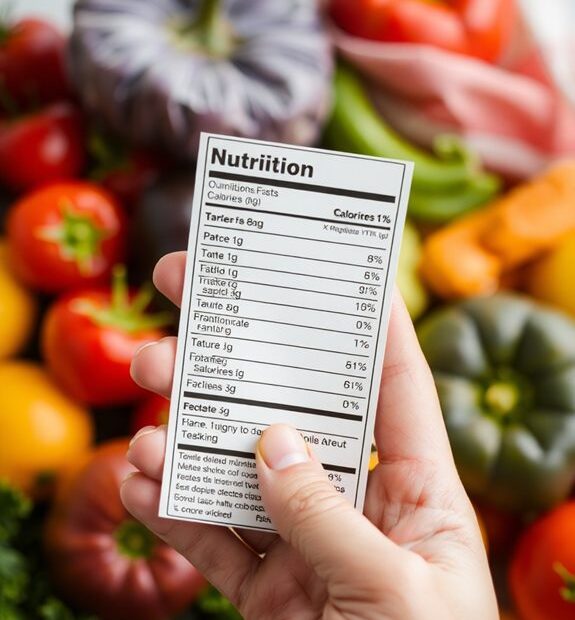To manage your weight better, start by checking serving sizes on nutrition labels. Ever notice how some servings are just a small handful? Next, look at the calorie count and consider how it fits into your daily goals. Don't forget to focus on the macronutrients like carbohydrates, proteins, and fats. Are there a lot of added sugars? Look out for names like high-fructose corn syrup! Finally, read the ingredient list; it tells you what's really in your food. By keeping these tips in mind, meal choices get easier! Want to discover more handy tips?
Key Takeaways
- Understand serving sizes to accurately gauge calorie intake and avoid overeating.
- Check total calories per serving to align with daily caloric goals for weight management.
- Identify added sugars on the label to minimize empty calories that hinder weight loss.
- Analyze fat types to favor unsaturated fats while avoiding trans and excessive saturated fats.
- Read ingredient lists to ensure you're choosing quality foods and avoiding unnecessary fillers.
Understanding Serving Sizes

When you glance at a nutrition label, the serving size is your starting point. It tells you how much of the food a single serving is, helping you understand what's in your meal. Have you ever poured a bowl of cereal and realized you've eaten three servings? Knowing the serving size can save you from those surprises! Accurate measurements, like those found in precision in measurements, are essential to avoiding tracking errors.
Serving sizes are often smaller than you think. For example, a bag of chips might list a serving as just 10 chips. If you eat the whole bag, you might be consuming way more calories and fat than you intended. 😱
It's important to compare the serving size with how much you usually eat. Are you a snacker? If you love munching, consider how many servings you're having. By doing this, you can make better choices that fit your goals.
Don't forget to check if the serving size is measured in cups, ounces, or pieces. This helps you grab the right amount. Remember, understanding serving sizes is a key step in managing your nutrition. So, the next time you eat, take a moment to check the label! You've got this!
Decoding Caloric Content
Understanding the caloric content of a food item is essential for managing your diet effectively. When you check the nutrition label, do you ever wonder how those calories can impact your weight? Knowing how to decode these numbers will help you make better choices. By incorporating meal prep strategies, you can create balanced meals that align with your caloric goals and enhance your overall health.
Here's what to look for on the label:
- Total Calories: This tells you how much energy you get from one serving.
- Calories from Fat: This shows how much of the total calories come from fat.
- Serving Size: Make sure you compare the calories based on the amount you're actually eating.
- Daily Values: Check how the calories fit into your daily intake goals.
- Hidden Additions: Some foods may have extra calories from added sugars or fats.
Identifying Nutritional Components

Identifying nutritional components on a food label is essential for making informed dietary choices. When you glance at a label, you might feel overwhelmed, but it doesn't have to be that way. Start by looking at the serving size. This tells you how much of the food is considered one serving. Have you ever noticed how a bag of chips can contain multiple servings? Meal planning can considerably enhance your understanding of these components, as it promotes mindfulness regarding nutritional content and balanced meals the importance of meal planning.
Next, check out the macronutrients: carbohydrates, proteins, and fats. These are the building blocks of your diet. For instance, if you're looking to build muscle, you might want to focus on higher protein options.
Don't forget about fiber! Foods high in fiber can help you feel full longer, which is great for weight management. A quick tip: aim for at least 3 grams of fiber per serving.
Lastly, look at vitamins and minerals. These help your body function properly. Are you getting enough Vitamin D or calcium?
Spotting Added Sugars
Added sugars can sneak into your diet in many forms, often hiding behind appealing product names. You might be surprised by how often they pop up in your favorite snacks and drinks. To make better choices, it's vital to spot these added sugars on nutrition labels.
Look for ingredients that can signal added sugars, such as:
- High-fructose corn syrup 🍬
- Sucrose (table sugar) 🍭
- Honey 🍯
- Agave nectar 🌵
- Molasses 🍂
When you read the label, check the "Total Sugars" section. If that number seems high, glance at the ingredients list. If you see any of the above names, you're likely consuming added sugars.
Are you wondering why this matters? Added sugars can contribute to weight gain and health issues. So, it's important to be aware of what you're eating.
Next time you're shopping, take a few moments to read those labels. It can really pay off in the long run! By choosing products with less added sugar, you'll not only feel better but also make smarter choices for your health. 🌟
Analyzing Fat Types

When you're checking nutrition labels for added sugars, it's just as important to analyze the types of fats listed. Fats can be tricky, right? But understanding them can help you make better choices for your health.
There are three main types of fats: saturated, trans, and unsaturated. Saturated fats, found in foods like butter and cheese, can raise your cholesterol levels. Too much can lead to heart problems. Trans fats, often found in processed snacks, are really bad for you and should be avoided. Unsaturated fats, like those in nuts and olive oil, are the good guys! They can actually help improve your heart health.
When you look at the label, check the total fat and see how much of it comes from these different types. Ask yourself, "Am I getting more healthy fats, or am I loading up on the bad ones?"
Interpreting Ingredient Lists
Ingredient lists can be a goldmine of information about the foods you eat. When you glance at a package, don't just focus on the shiny labels; instead, dive deeper into the ingredients. Do you really know what's in your food? Understanding these lists helps you make better choices for your health.
Here are a few key points to look for:
- First ingredient: It's the main ingredient. Is it something whole and healthy?
- Added sugars: They sneak in under different names. Watch out!
- Preservatives: Do you recognize them? If not, maybe skip it.
- Filler ingredients: These often add bulk but little nutrition.
- Allergens: Keep an eye out for common allergens like nuts or gluten.

